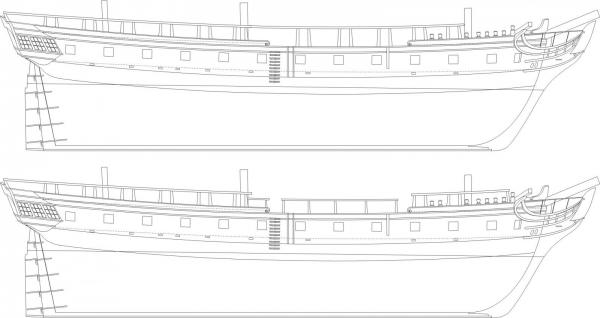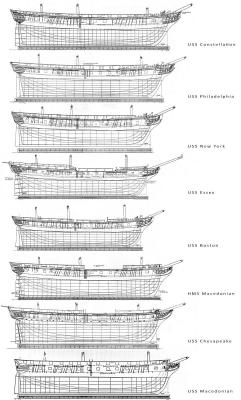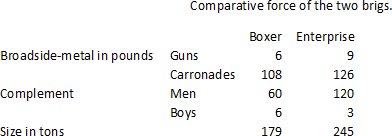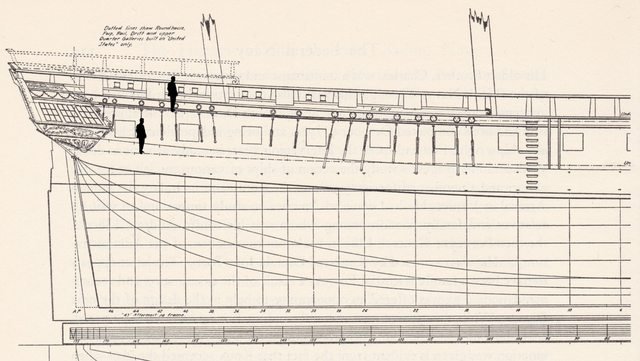
Talos
-
Posts
409 -
Joined
-
Last visited
Content Type
Profiles
Forums
Gallery
Events
Posts posted by Talos
-
-
I don't know any others off the top of my head, since she was built down in Charleston. Fox, who was designer but not builder, designed the Philadelphia too, whose railings the second one is mostly inspired by. The third one is the same as the first, but with the addition of forecastle rails and little stub rails at the entryway.
-
- CharlieZardoz, mtaylor and Canute
-
 3
3
-
That is the plan.
- mtaylor, Canute, uss frolick and 1 other
-
 4
4
-
Those are interesting choices. I also find the rebuilt Peacock interesting to look at (though far inferior to the original ship, much more extreme hull lines, too sharp to carry as much weight). She was intended to look much like the original ship, but features an updated look, including large carronade ports and a round stern.
- CharlieZardoz and mtaylor
-
 2
2
-
-
It's the original construction plan, but things could always be tweaked a bit and ships were never 100% as they were on those plans. Just look at Frolic and Peacock, they were all nominally built ot the same draught. Only a draught "as-built" would be 100% accurate. As a bit of trivia, the construction plan goes to the inside of the planking, while Peacock's as-built probably goes to the outside of the planking. You see something similar with Macedonian, where the original replacement frigate draught goes to the inside, while the draught of the razee is to the outside, so if you overlay them, the sloop of war's plans are slightly bigger in all dimensions.
-
It's possible Peacock had the galleries added later in a refit at some point, something Wasp obviously couldn't have since she was lost before the end of the war.
- mtaylor and CharlieZardoz
-
 2
2
-
Yeah, Wasp might have been built with galleries, but the original design draught I was talking about shows the badges originally planned there.
- CharlieZardoz and mtaylor
-
 2
2
-
Both Wasp (the second one) and Syren's draughts show quarterbadges on the stern, not galleries. Wasp's sister, Peacock's, lines taken off before they scrapped her show a poop deck and quarter galleries though.
- mtaylor and CharlieZardoz
-
 2
2
-
It's certainly the later sloop, the original sloop would have had a more stereotypical stern like the other frigates. The Perry and Lawrence weren't launched until the 1840s, after John Adams was rebuilt. St Louis there is another one of the three designs for the 1820s sloops, she's out of scale with the other drawings. Congress' looks like the replaced version of that frigate too, though flattened out (it's a round stern) and missing the quarter galleries.
- mtaylor and CharlieZardoz
-
 2
2
-
Anyone have thoughts about some of the figureheads of the subscription frigates. Do descriptions survive?
Frolick discusses the Essex figurehead in another thread here. http://modelshipworld.com/index.php/topic/3272-the-two-possible-sterns-of-the-frigate-essex/?p=93243
As I recall, John Adams had a carved figurehead of the politician, which was later replaced by a fiddlehead before being restored and then transferred to the replacement sloop of war like Macedonian's. I believe William Rush carved both John Adams' and Philadelphia's figureheads, the latter of which was a figure of Hercules (The ship of the line Pennsylvania built after the War of 1812 got a Hercules figurehead too).
By the years leading up to the War of 1812, cheaper and more durable fiddleheads were the order of the day on most ships.
- CharlieZardoz, druxey and mtaylor
-
 3
3
-
Thanks, druxey!
I believe they are supposed to be skylights, actually. I based their height below the deck above on identical ones visible on the Essex and Boston draughts. You can see those on this comparison I'm uploading. The second Macedonian at the bottom also has them, while Chesapeake has scuttles. Essex's draught in Chapelle has them labled skylights.
- druxey, CharlieZardoz, mtaylor and 3 others
-
 6
6
-
I poked around this evening, searching for Navy Registers for the lieutenant. I had a candidate, even wrote up an entry from a register in 1905, then realized he was 1st Lieutenant of the corvette Adams, not the corvette John Adams, in 1814. I also looked at a hearing about James Barron (of Chesapeake-Leopard fame) who was discharged and doing commercial work in Europe during the war. He tried to hitch a ride on John Adams back to the US in 1814 to "help" the Navy.
With regards to Angus' mental instability, his 1840 obituary talks about it some. It's how he got summarily discharged without a hearing.
May 29 – At Geneva, NY, aged 56, Captain Samuel Angus, formerly of the US Navy. He was born in Philadelphia in 1784, entered the service of the US at the age of 15 years; was promoted, in 1807, to the rank of Lieutenant, in 1813, to that of Master-Commandant, and, in 1816, to that of Captain. He was several times severely wounded; in 1800, in an action between the Constellation and the French frigate La Vengeance; and soon after in an action between the schooner Enterprise and a French lugger; in 1812, in an attack upon the English opposite to Black Rock, and afterwards while commanding the Flotilla on Delaware Bay. He was selected by Messrs. Adams and Clay, commissioners for forming a treaty, which was afterwards concluded at Ghent, to convey them to Europe. “Although impaired in mind and debilitated in body by the injuries he had received in the public service, he still continued to discharge the duties of his rank, till, suffering a temporary derangement of mind produced by the severity of his wounds, he address to the head of the Navy Department a letter that was considered disrespectful, for which he was dismissed, without trial, from a service which his courage and generosity had honored. Those, who knew him, always admired him as an able and intrepid officer, as a generous and devoted friend, and an ardent patriot.”
I did find that the John Adams' muster and pay rolls for 1814 are in the National Archives, as seen here. http://www.archives.gov/research/alic/reference/military/navy-records-1789-to-1925.htmlYou might be able to drop them an email and have a researcher look it up. it should be easy for them to do.
- Canute, uss frolick, druxey and 1 other
-
 4
4
-
This past spring, ussfrolic reached out to me about collaborating on a project with the US frigate John Adams. He got me access to a copy of a design draught for her and I duly reconstructed it from there. I’ve been sitting on it for a couple months since then and hadn’t started the proper thread for it. At frolic’s prompting I’m finally getting it started. He’ll fill in more of the background in following posts.
I intend to do more with the drawings, including an attempt to illustrate later versions of the ship, including the sloop and jackass frigate years. I also found spar dimensions for her as of the Barbary Wars, so I’ll be drawing a sail plan as well. The bare hull isn't entirely finished yet either, there’s still a few bits here and there missing, but it’s overall complete. I suppose “fitted out” would be a better term…
I reconstructed the steps, side lights from a deckplan that showed them, the bridle ports, and the head and waist rails. I’m going to fiddle with a couple different designs for the rails as far as waist and forecastle, but this is a start.
- capnharv2, reilly, CaptArmstrong and 8 others
-
 11
11
-
-
Agreed. Might not have had one as-built, but certainly had one at least when it became a brig, if not after the Venice refit. Pay attention to the difference between heads around 1800 and by the War of 1812, the shapes had really changed by then.
-
I imagine a large part of the head on small naval ships like that is fashion, essentially marking it as a "real" naval vessel. Chapelle has several examples of ships in the same class that have or don't have the naval heads, like the USS Alligator/Shark and USRC Morris/Hamilton. All of those are schooners though, I can't think of any brigs or larger that lack those heads.
-
If I'm not mistaken, when a ship with square sails is taking the wing, it helps keep it heeled over steadily.
Amusingly, ship-sloops were far more capable of taking battle damage than a brig-sloop, since the loss of only one or two sails or a single mast can disable it, while the ship-sloop can handle the loss of any of the three masts.
- mtaylor, CharlieZardoz and Canute
-
 3
3
-
Yeah, when they built the new, longer bow, the lines were sharper. It makes sense with both being built up from the same frame, the longer bow will be less bluff than the original ship. When I get around to doing Santee/Sabine drawings, I'm looking forward to modeling Sabine's different bow, stern, and mast placement.
Also, looking at Chapelle again, it was Tingley, the Commandant at the Washington Navy Yard, who had Enterprise, Vixen, Viper, and Nautilus converted to brigs (over the objection of Fox).
- Canute and CharlieZardoz
-
 2
2
-
Option 1 makes much more sense, of course and is certainly what they did in the 1811/1812 refit in Washington too.
Chapelle states something differerent for Sabine and Santee though. He says that 15 feet was added by cutting the bow off and building a brand new, longer, bow and the frames aft of frame 31 (before the mizzen, right around the aft end of the mainmast's channels) taken down and changed, with Santee also getting much less rake in the bow and stern (Sabine kept the same as St Lawrence's).
- Canute and CharlieZardoz
-
 2
2
-
I doubt any change was made to her keel then. They widened her deck (reducing tumblehome), but the officer referred to wanting to lengthen her more, as you'll recall. I imagine that any difference in length was smaller things like respacing frames, changing the rake of the stem and stern, etc. James was saying Enterprise was 88 ft 7in though. (97ft 1in gundeck length minus the 8ft 6in he added based on Nautilus) Close enough to be a difference in measuring.
-
Is this source insinuating that Enterprize was lengthened after the war? Could she have been lengthened twice? At 97' that would make her larger than the Syren?? Am I correct in assuming that this was written by a British historian in 1817? If that is so it is likely he didn't have the correct information and made an inference on size and date of alteration. Very interesting stuff though I downloaded the book via an online source
 And I agree trippwj, these little warships were so very compact and cramp when you really think about it it's simply amazing and for me why I think I like them so much. Sure a big ship like Vanguard or Victory are feats on engineering, but these small ships fascinate me in how the engineers managed to work with limited space in order to make such beautiful vessels which were essentially very practical works of art.
And I agree trippwj, these little warships were so very compact and cramp when you really think about it it's simply amazing and for me why I think I like them so much. Sure a big ship like Vanguard or Victory are feats on engineering, but these small ships fascinate me in how the engineers managed to work with limited space in order to make such beautiful vessels which were essentially very practical works of art. 
Actually, no, he was referring to a refit at the Washington Naval Yard between October 1811 and the beginning of May 1812, where Enterprise was taken out of the water, given the length increase, and rerigged as a brig. (“Soon after the late war commenced”, as in right at the start of the War of 1812) So just once. Her keel length before that date was the same as when she was launched.
William James was a very pro-British lawyer and his work was focused on showing that the RN didn’t really “lose” any of the single-ship duels of the War of 1812, because the American ships always outclassed their opponents in size, crew, and firepower (Constitution, United States, Wasp, Hornet, etc). He easily would have gone with the American measurements if it made them look even bigger.
His numbers for Enterprise were very accurate though. As I mentioned in that post, they took a memorandum book from USS Chesapeake when she was captured. In it were full dimensions (including full spar and sail dimensions!) for at least Constitution, President, Chesapeake, and the Enterprise as a schooner (obviously wasn’t updated after her 1812 refit when she was turned into a brig). James mentions as proof of the book’s accuracy that President and Chesapeake’s numbers were checked against the captured warships. I think that this book, if it survives, could be invaluable. I did find reference to a signal book from Chesapeake in the British archives, which this could have come from, or it might be a different book that might be collecting dust somewhere.
The reason he brought up Nautilus is the brig was laid up in Deptford (as HMS Emulous) from 1816 to 1817, while he was writing this. He was using the exact gunport spacing between two of her ports, either measuring her himself or going from measurements taken off of her during that time laid up and added that to the known length of Enterprise from the memorandum book (knowing that a gunport was added to each side). It’s possible her lines were taken then too. She was probably closest to Enterprise as-built anyway, being a fellow Baltimore Clipper schooner from the same time period before 1800 as well as possibly being built by the same man (Henry Spencer).
- Canute, uss frolick and CharlieZardoz
-
 3
3
-
Taken from "A Full and Correct Account of the Chief Naval Occurrences of the Late War Between Great Britain and the United States of America" by William James.
The Enterprise was originally a schooner; and her full dimensions, in hull, spars, and sails, as a schooner, appear in the M.S. memorandum-book, before referred to. (See p. 111.) Soon after the late war commenced, the Enterprise was cut in two, lengthened, (so as to have one more port of a-side,) and altered to a brig, at Washington. The Nautilus, captured by the Shannon, was also originally a schooner; and was altered to a brig without being lengthened. By adding, therefore, to the Enterprise’s original length, the distance between the fore-side of one of the Nautilus’s ports, to the aft side of the next port, which is 8 feet 6 inches, we have the present length of the Enterprise. This makes her 245 tons; but several British officers who have seen the Enterprise, state that she is about 260 tons. The Nautilus’s top-sides are nearly as stout as those of our first-class brigs; while the Boxer had only one timber between each port; which made her top-sides pervious to every grape-shot that was fired. The spars of the Enterprise will be considered as no larger, than those which the Nautilus had, when captured.

This is the proper place to give an extract from the American “Particulars;” – “At 3 PM tacked, and bore up for the enemy, taking him to be one of his majesty’s brigs of the largest size”!
None of the praises lavished upon the “fine brig of war Boxer”, could gain her a place among the national vessels of the United States. She was put up to auction, and sold as a merchant-brig; for which service only, (and that in peaceable times,) she was ever calculated.
The superiority in weight of metal is trifling; that in number of men, two-fold. Gun-brigs are allowed but one lieutenant, one master’s mate, and two midshipmen. The absence of the two midshipmen, the shameful defection of the acting master’s-mate, and the three seamen, and the fall of her brave commander by the first broadside, rendered the Boxer’s situation, at the very onset of the engagement, peculiarly unfortunate. On the other hand, the Enterprise, after her commander was wounded, had still two lieutenants, and four or five midshipmen, left, to carry on the action. These circumstances considered, the disparity between the two crews, was even greater than the numerical difference, already so great.
None, but a novice in American history, will be surprised at the following paragraph in Mr. Low’s book: “The President of the United States, have considered the Boxer as equal in force to the Enterprise, has ordered her to be delivered up for the benefit of the captors.”The MS Memorandum book is described earlier in the book. It was captured by the RN when they took the Chesapeake and had dimensions for multiple ships. It might still exist in the British archives.
- Canute, uss frolick, CharlieZardoz and 1 other
-
 4
4
-
While United States probably had single-story quartergalleries, Chapelle does attempt a reconstruction of two-level ones for it. They would just be an extension of the top of the gallery with false windows just like the lower level. HMS President, the replacement for the captured US frigate built on roughly the same lines, did have one though. While the rest of the stern is completely different, it can give a decent idea of what those kind of quartergalleries could look like. http://s017.radikal.ru/i428/1212/a2/78007cc6952c.jpg
Returning to Chapelle again, his as-built draught for the Constitution and her sisters have a strange stern. The galleries and stern itself are really high up compared to the deck. The as-captured USS President draught the British took off has a lower gallery, as does the Java-class and other related frigates. I dropped in a pair of ~6 foot tall figures, one on the gun deck and one on the spar deck to illustrate. The dashed lines are his attempt at reconstructing United States' poop deck and extended quartergalleries.






The subsciption frigate New York and other details
in Nautical/Naval History
Posted
Sorry for the belated reply. Fun start on this thread, the subscription frigates are a fun topic.
First attachment is a better version of the side profile from Chapelle. I'll post the rest of it later, I need to stitch it back together.
The second is a set of New York plans from Barbary Wars: Register of Officer, Personnel, and Ship's Data. This is the original source of Chapelle's drawing and the only draught he could find. It was drawn by Henry Allen at a later date from offsets. It displays incorrect solid bulwarks and a head and cutwater of a later period frigate. Chapelle backdated the appearance to the "standard" look of American frigates of the era, including partial measurements given by Samuel Humphreys in a memorandum to his offset book, which was missing when Chapelle looked. He also points out that the hawseholes in the plan would be technically impossible where they are. Her only plan that survived, which he used to detail his take on the ship, is an inboard profile. You can see that he opened up the bulwarks, but kept the same lines.
The Philadelphia plan is the same (with a sail plan that survived too) and was made at a later date too. I'm attaching that to the post as well.